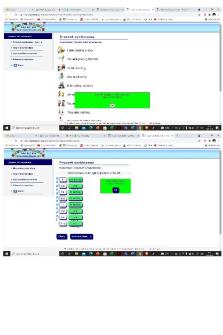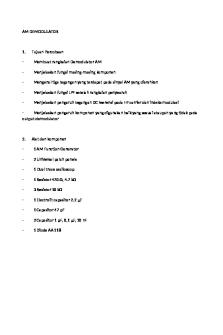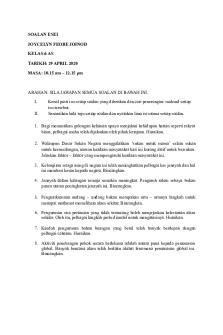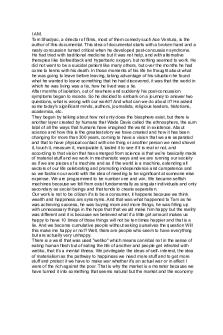E-Notes PDF All-Units 30042019 052142 AM PDF

| Title | E-Notes PDF All-Units 30042019 052142 AM |
|---|---|
| Author | abhishek parmar |
| Course | Computer Engineering |
| Institution | Indus University |
| Pages | 160 |
| File Size | 10 MB |
| File Type | |
| Total Downloads | 73 |
| Total Views | 118 |
Summary
ha ha bhai ha ha ha ha ha ha ha bhai bolo to you and your family a a very happy...
Description
Unit 1 – Register Transfer Language 1.
Explain the Register Transfer Language. Definition: The symbolic notation used to describe the microoperation transfers among registers is called a register transfer language. The term "register transfer" implies the availability of hardware logic circuits that can perform a stated microoperation and transfer the result of the operation to the same or another register. The word "language" is borrowed from programmers, who apply this term to programming languages. A register transfer language is a system for expressing in symbolic form the microoperation sequences among the registers of a digital module. It is a convenient tool for describing the internal organization of digital computers in concise and precise manner. It can also be used to facilitate the design process of digital systems. Information transfer from one register to another is designated in symbolic form by means of a replacement operator. The statement below denotes a transfer of the content of register R1 into register R2. R2 ← R1 A statement that specifies a register transfer implies that circuits are available from the outputs of the destination register has a parallel load capability. Every statement written in a register transfer notation implies a hardware construction for implementing the transfer.
2.
Explain the Register Transfer in detail with block diagram and timing diagram. Definition: Information transfer from one register to another is designated in symbolic form by means of a replacement operator is known as Register Transfer. R2 ← R1 Denotes a transfer of the content of register R1 into register R2. Computer registers are designated by capital letters (sometimes followed by numerals) to denote the function of the register. For example: MAR Holds address of memory unit PC Program Counter IR Instruction Register R1 Processor Register
Below figure1.1 shows the representation of registers in block diagram form.
Swati Sharma , CE Department
| 2140707 – Computer Organization
1
Unit 1 – Register Transfer Language
Figure 1.1: Block diagram of register
The most common way to represent a register is by a rectangular box with the name of the register inside, as shown in figure. Bits 0 through 7 are assigned the symbol L (for low byte) and bits 8 through 15 are assigned the symbol H (for high byte). The name of the 16-bit register is PC. The symbol PC(0-7) or PC(L) refers to the low-order byte and PC(8-15) or PC(H) to the high-order byte. The statement that specifies a register transfer implies that circuits are available from the outputs of the source register to the inputs of the destination register and that the destination register has a parallel load capability.
Register Transfer with control function: If we want the transfer to occur only under a predetermined control condition. This can be shown by means of an if-then statement. If (P = 1) then (R2 R1) where P is a control signal. It is sometimes convenient to separate the control variables from the register transfer operation control function by specifying a control function. A control function is a Boolean variable that is equal to 1 or 0. The control function is included in the statement as follows: P: R2 R1 The control condition is terminated with a colon. It symbolizes the requirement that the transfer operation be executed by the hardware only if P = 1. Every statement written in a register transfer notation implies a hardware construction for implementing the transfer. Below figure shows the block diagram that depicts the transfer from R1 to R2.
Figure 1.2: Transfer from R1 to R2 when P = 1
Figure 1.3: Timing diagram Swati Sharma , CE Department
| 2140707 – Computer Organization
2
Unit 1 – Register Transfer Language
3.
The n outputs of register R1 are connected to the n inputs of register R2. The letter n will be used to indicate any number of bits for the register. In the timing diagram, P is activated in the control section by the rising edge of a clock pulse at time t. The next positive transition of the clock at time t + 1 finds the load input active and the data inputs of R2 are then loaded into the register in parallel. P may go back to 0 at time t + 1; otherwise, the transfer will occur with every clock pulse transition while P remains active. The basic symbols of the register transfer notation are listed in Table below: Symbol Letters (and numerals) Parentheses ( )
Description
Examples
Denotes a register
MAR, R2 R 2(0-7), R2(L)
Arrow Comma ,
Denotes a part of a register Denotes transfer of information
R2R1 Separates two micro operations R2R1, R1R2 Table 1.1: Basic Symbols for Register Transfers
Registers are denoted by capital letters, and numerals may follow the letters. Parentheses are used to denote a part of a register by specifying the range of bits or by giving a symbol name to a portion of a register. The arrow denotes a transfer of information and the direction of transfer. A comma is used to separate two or more operations that are executed at the same time. The statement below, denotes an operation that exchanges the contents of two registers during one common clock pulse provided that T = 1. T: R2 R1, R1 R2 This simultaneous operation is possible with registers that have edge-triggered flipflops.
Design and explain a common bus system for four register.
A typical digital computer has many registers, and paths must be provided to transfer information from one register to another. The number of wires will be excessive if separate lines are used between each register and all other registers in the system. A more efficient scheme for transferring information between registers in a multipleregister configuration is a common bus system. A bus structure consists of a set of common lines, one for each bit of a register, through which binary information is transferred one at a time.
Swati Sharma , CE Department
| 2140707 – Computer Organization
3
Unit 1 – Register Transfer Language
Control signals determine which register is selected by the bus during each particular register transfer. One way of constructing a common bus system is with multiplexers. The multiplexers select the source register whose binary information is then placed on the bus. The construction of a bus system for four registers is shown in figure below. Each register has four bits, numbered 0 through 3. The bus consists of four 4 x 1 multiplexers each having four data inputs, 0 through 3, and two selection inputs, S1 and S0. The diagram shows that the bits in the same significant position in each register are connected to the data inputs of one multiplexer to form one line of the bus.
4-line common bus S1 S0
4x1
4x1
4x1
4x1
MUX 3
MUX 2
MUX 1
MUX 0
D2 C2 B2 A2
D2 D1 D0
3 2
1 0
Register D
C2 C1 C0
3 2
1 0
Register C
D1 C1 B1 A1
B2 B1 B0
3 2
1 0
Register B
D0 C0 B0 A0
A2 A1 A0
3 2
1 0
Register A
Figure 1.4: Bus system for four registers
The two selection lines S1 and S0 are connected to the selection inputs of all four multiplexers. The selection lines choose the four bits of one register and transfer them into the fourline common bus. S1 S0 Register selected 0 0 A 0 1 B
Swati Sharma , CE Department
| 2140707 – Computer Organization
4
Unit 1 – Register Transfer Language 1 1
0 1
C D
Table 1.2: Function Table for Bus
4.
When S1S0 = 00, the 0 data inputs of all four multiplexers are selected and applied to the outputs that form the bus. This causes the bus lines to receive the content of register A since the outputs of this register are connected to the 0 data inputs of the multiplexers. Similarly, register B is selected if S1S0 = 01, and so on. Table shows the register that is selected by the bus for each of the four possible binary values of the selection lines. In general, a bus system will multiplex k registers of n bits each to produce an n-line common bus. The number of multiplexers needed to construct the bus is equal to n, the number of bits in each register. The size of each multiplexer must be K x 1 since it multiplexes K data lines. For example, a common bus for eight registers of 16 bits each requires 16 multiplexers, one for each line in the bus. Each multiplexer must have eight data input lines and three selection lines to multiplex one significant bit in the eight registers.
A digital computer has a common bus system for 16 registers of 32 bits each. (i) How many selection input are there in each multiplexer? (ii) What size of multiplexers is needed? (iii) How many multiplexers are there in a bus? (i) How many selection input are there in each multiplexer? 2n=No. of Registers; n=selection input of multiplexer 2n=16; here n=4 Therefore 4 selection input lines should be there in each multiplexer. (ii) What size of multiplexers is needed? size of multiplexers= Total number of register X 1 = 16 X 1 Multiplexer of 16 x 1 size is needed to design the above defined common bus. (iii) How many multiplexers are there in a bus? No. of multiplexers = bits of register = 32 32 multiplexers are needed in a bus.
Swati Sharma , CE Department
| 2140707 – Computer Organization
5
Unit 1 – Register Transfer Language 5.
Explain three-state bus buffer. OR Explain the operation of three state bus buffers and show its use in design of common bus.
A bus system can be constructed with three-state gates instead of multiplexers. A three-state gate is a digital circuit that exhibits three states. State 1: Signal equivalent to Logic 1 State 2: Signal equivalent to Logic 0 State 3: High Impedance State (behaves as open circuit) The high-impedance state behaves like an open circuit, which means that the output is disconnected and does not have logic significance. The most commonly used design of a bus system is the buffer gate. The graphic symbol of a three-state buffer gate is shown in figure 1.5 below: Normal Input A
Output Y=A if C=1 High Impedance if C=0
Control Input C
Figure 1.5: Graphic symbols for three-state buffer
It is distinguished from a normal buffer by having both a normal input and a control input. The control input determines the output state. When the control input C is equal to 1, the output is enabled and the gate behaves like any conventional buffer, with the output equal to the normal input. When the control input C is 0, the output is disabled and the gate goes to a highimpedance state, regardless of the value in the normal input. The high-impedance state of a three-state gate provides a special feature not available in other gates. Because of this feature, a large number of three-state gate outputs can be connected with wires to form a common bus line without endangering loading effects. The construction of a bus system with three-state buffers is demonstrated in figure 1.6 below:
Swati Sharma , CE Department
| 2140707 – Computer Organization
6
Unit 1 – Register Transfer Language Bus line for bit 0
A0 B0 C0 D0 S1
0
Select
S0
2x4
Enable
Decoder
1 2 3
Figure 1.6: Bus line with three state-buffers
The outputs of four buffers are connected together to form a single bus line. The control inputs to the buffers determine which of the four normal inputs will communicate with the bus line. No more than one buffer may be in the active state at any given time. The connected buffers must be controlled so that only one three-state buffer has access to the bus line while all other buffers are maintained in a high impedance state. One way to ensure that no more than one control input is active at any given time is to use a decoder, as shown in the figure: Bus line with three state-buffers. When the enable input of the decoder is 0, all of its four outputs are 0, and the bus line is in a high-impedance state because all four buffers are disabled. When the enable input is active, one of the three-state buffers will be active, depending on the binary value in the select inputs of the decoder. To construct a common bus for four registers of n bits each using three- state buffers, we need n circuits with four buffers in each as shown in figure: Bus line with three state-buffers, Each group of four buffers receives one significant bit from the four registers. Each common output produces one of the lines for the common bus for a total of n lines. Only one decoder is necessary to select between the four registers.
Swati Sharma , CE Department
| 2140707 – Computer Organization
7
Unit 1 – Register Transfer Language 6.
Explain Memory Transfer
Read Operation: The transfer of information from a memory word to the outside environment is called a read operation. Write Operation: The transfer of new information to be stored into the memory is called a write operation. A memory word will be symbolized by the letter M. It is necessary to specify the address of M when writing memory transfer operations. This will be done by enclosing the address in square brackets following the letter M. Consider a memory unit that receives the address from a register, called the address register, symbolized by AR. The data are transferred to another register, called the data register, symbolized by DR. The read operation can be stated as follows: Read: DR M[AR] This causes a transfer of information into DR from the memory word M selected by the address in AR. The write operation transfers the content of a data register to a memory word M selected by the address. Assume that the input data are in register R1 and the address is in AR. Write operation can be stated symbolically as follows: Write: M[AR] R1 This causes a transfer of information from R1 into memory word M selected by address AR.
Swati Sharma , CE Department
| 2140707 – Computer Organization
8
Unit 1 – Register Transfer Language 7.
Explain Arithmetic Micro-operation.
The basic arithmetic micro-operations are: 1. Addition 2. Subtraction 3. Increment 4. Decrement 5. Shift The additional arithmetic micro operations are: 1. Add with carry 2. Subtract with borrow 3. Transfer/Load , etc. Summary of Typical Arithmetic Micro-Operations: Contents of R1 plus R2 transferred to R3 Contents of R1 minus R2 transferred to R3 R2 R2’ Complement the contents of R2 R2 R2’+ 1 2's complement the contents of R2 (negate) R3 R1 + R2’+ subtraction 1 R1 R1 + 1 Increment R1 R1 – 1 Decrement R3 R1 + R2 R3 R1 - R2
8.
Explain Binary Adder in detail
To implement the add micro operation with hardware, we need : 1. Registers : that hold the data 2. Digital component: that performs the arithmetic addition. Full-adder The digital circuit that forms the arithmetic sum of two bits and a previous carry is called a full-adder. Binary adder The digital circuit that generates the arithmetic sum of two binary numbers of any lengths is called a binary adder. The binary adder is constructed with full-adder circuits connected in cascade, with the output carry from one full-adder connected to the input carry of the next full-adder.
Swati Sharma , CE Department
| 2140707 – Computer Organization
9
Unit 1 – Register Transfer Language B3 FA
C4
B2
A3
S3
C3
B1
A2 FA
C2
S2
B0
A1 FA
S1
C1
A0 FA
C0
S0
Figure 1.7: 4-bit binary adder
9.
Above figure 1.7 shows the interconnections of four full-adders (FA) to provide a 4-bit binary adder. The augends bits of A and the addend bits of B are designated by subscript numbers from right to left, with subscript 0 denoting the low-order bit. The carries are connected in a chain through the full-adders. The input carry to the binary adder is C0 and the output carry is C4. The S outputs of the full-adders generate the required sum bits. An n-bit binary adder requires n full-adders. The output carry from each full-adder is connected to the input carry of the next-highorder full-adder. The n data bits for the A inputs come from one register (such as R1), and the n data bits for the B inputs come from another register (such as R2). The sum can be transferred to a third register or to one of the source registers (R1 or R2), replacing its previous content.
Explain Binary Adder-Subtractor in detail.
The subtraction of binary numbers can be done most conveniently by means of complements. Remember that the subtraction A - B can be done by taking the 2's complement of B and adding it to A. The 2's complement can be obtained by taking the l's complement and adding one to the least significant pair of bits. The l's complement can be implemented with inverters and a one can be added to the sum through the input carry. The addition and subtraction operations can be combined into one common circuit by including an exclusive-OR gate with each full-adder. The mode input M controls the operation. When M = 0 the circuit is an Adder When M = 1 the circuit becomes a Subtractor Each exclusive-OR gate receives input M and one of the inputs of B. When M = 0, We have C0=0 B ⊕ 0 = B The full-adders receive the value of B, the input carry is 0, and the circuit performs A
Swati Sharma , CE Department
| 2140707 – Computer Organization
10
Unit 1 – Register Transfer Language plus B. When M = 1, We have
C0=1 B ⊕ 1 = B` ; B complement
The B inputs are all complemented and 1is added through the input carry. The circuit performs the operation A plus the 2's complement of B.
A + 2’s compliment of B A 4-bit adder-subtractor circuit is shown as follows: B3
A3
B2
A2
B1
A1
B0
A0
M
FA
C4
10.
S3
C3
FA
C2
FA
C1
S2 S1 Figure 1.8: 4-bit Adder-Subtractor
FA
C0
S0
For unsigned numbers, If A>=B, then A-B If A logic ‘0’ D=A+0+ Cin If Cin=0, D=A; Transfer A If Cin=1, D=A+1;Increment A When S1 S0= 1 1 Input B is neglected and Y=> logic ‘1’ D=A-1+ Cin If Cin=0, D=A-1; 2’s compliment If Cin=1, D=A; Transfer A
Note that the micro-operation D = A is generated twice, so there are only seven distinct micro-operations in the arithmetic circuit.
Draw and explain Logic Micro-operations in detail.
...
Similar Free PDFs

E-Notes PDF All-Units 30042019 052142 AM
- 160 Pages

MPO - enotes
- 2 Pages

Am is are - Apuntes Am, is ,are
- 2 Pages

AM DEMODULATOR
- 9 Pages

Lab5-09042020-123820 am
- 4 Pages

ESEI Pengajian AM
- 3 Pages

Ensayo I AM SAM
- 3 Pages

Zusammenfassung-AM-Finance
- 14 Pages

Artigo Modulação AM-VSB
- 4 Pages

Solución de ejercicios AM
- 22 Pages

AM RTJ-06-2067
- 2 Pages

Ebenen am Gesichtsschädel
- 1 Pages

AM 1 Chami - Ordoñez
- 224 Pages

Zusammenfassung AM Finance
- 14 Pages
Popular Institutions
- Tinajero National High School - Annex
- Politeknik Caltex Riau
- Yokohama City University
- SGT University
- University of Al-Qadisiyah
- Divine Word College of Vigan
- Techniek College Rotterdam
- Universidade de Santiago
- Universiti Teknologi MARA Cawangan Johor Kampus Pasir Gudang
- Poltekkes Kemenkes Yogyakarta
- Baguio City National High School
- Colegio san marcos
- preparatoria uno
- Centro de Bachillerato Tecnológico Industrial y de Servicios No. 107
- Dalian Maritime University
- Quang Trung Secondary School
- Colegio Tecnológico en Informática
- Corporación Regional de Educación Superior
- Grupo CEDVA
- Dar Al Uloom University
- Centro de Estudios Preuniversitarios de la Universidad Nacional de Ingeniería
- 上智大学
- Aakash International School, Nuna Majara
- San Felipe Neri Catholic School
- Kang Chiao International School - New Taipei City
- Misamis Occidental National High School
- Institución Educativa Escuela Normal Juan Ladrilleros
- Kolehiyo ng Pantukan
- Batanes State College
- Instituto Continental
- Sekolah Menengah Kejuruan Kesehatan Kaltara (Tarakan)
- Colegio de La Inmaculada Concepcion - Cebu

